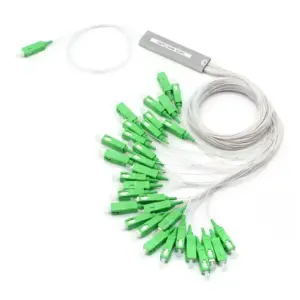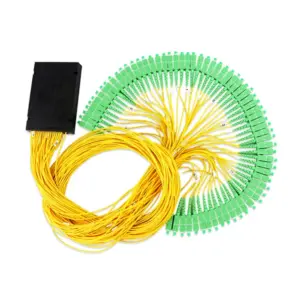Hello! I am pleased to introduce to you the 1×3 PLC fiber optic splitter, an indispensable innovative product in optical communication systems. Let us understand its basic definition, working principle and important role in optical communications.
As an efficient and stable fiber optic splitter, the 1×3 PLC fiber optic splitter stands out for its excellent technical parameters and performance characteristics. It uses PLC (Planar Waveguide Grating) technology, which can divide one input optical signal into three outputs to realize the distribution and routing of optical signals.
I. Basic knowledge of 1×3 PLC optical fiber splitter
Basic definition and working principle:
- The “1” in “1×3” represents one input port, while “3” represents three output ports. This shows that the optical splitter can distribute an input optical signal to three different output channels.
- 1×3 PLC optical fiber splitter is manufactured based on planar waveguide technology. The input optical signal is distributed to each output port according to a certain proportion through optical distribution devices.
The meaning and function of 1×3:
- 1×3 represents the structure of the optical splitter, where “1” represents one input port and “3” represents three output ports. This means that the 1×3 PLC fiber optic splitter can split an input optical signal into three outputs to achieve distribution and sharing of optical signals.
- In optical communications, 1×3 PLC fiber optic splitter can be used to distribute a single optical signal to multiple destinations, such as different receivers, detectors or fiber optic sensors, to meet different communication needs.
In summary, the 1×3 PLC optical fiber splitter has a structure of one input port and three output ports, which can distribute the input optical signal to multiple output channels, providing an effective optical distribution solution for optical communication systems .
II. Analysis of technical performance and advantages
Parameters and performance features:
-
Splitting ratio: 1×3 PLC optical fiber splitter distributes an input optical signal to three output channels, realizing the distribution and sharing of optical signals.
-
Wavelength range: Usually has the characteristics of a wide wavelength range and can support the transmission of optical signals of multiple wavelengths.
-
Insertion loss: Insertion loss is usually low, ensuring the stability and quality of optical signals during transmission.
-
Cross-coupling: It can reduce cross-coupling between different output channels and ensure the purity and stability of optical signals.
Advantages and Stability:
-
High splitting ratio: The 1×3 PLC fiber optic splitter can evenly distribute the input optical signal to three output channels to meet the optical signal needs of multiple destinations.
-
Stability and reliability: Using high-quality materials and precision manufacturing processes, it has good stability and reliability, and performs well under long-term operation and various environmental conditions.
-
Low loss: Low insertion loss ensures the transmission quality and stability of optical signals and reduces the overall loss of the optical communication system.
-
Flexibility and scalability: 1×3 PLC optical fiber splitter can meet the needs of different optical communication systems, has good flexibility and scalability, and is suitable for various complex optical network environments.
In summary, the 1×3 PLC optical fiber splitter has excellent technical performance and stability, plays an important role in optical signal transmission, and provides a reliable optical distribution solution for the design and deployment of optical communication systems.
III. Typical application scenarios and case sharing
Application scenarios:
-
Optical fiber access network: In access networks such as FTTH and FTTB, 1×3 PLC fiber optic splitters are used to distribute optical signals to multiple user terminals to achieve coverage of fiber optic access and broadband services.
-
Optical sensor network: In the optical fiber sensor network, the 1×3 PLC optical fiber splitter is used to transmit optical signals to different sensor nodes to realize the monitoring and data collection of optical signals.
-
Data center optical interconnection: In the optical interconnection of data centers, 1×3 PLC optical fiber splitters are used to distribute optical signals to different servers or storage devices to achieve data transmission and integration.
Application cases:
-
Urban communication network: In the deployment of urban communication networks, 1×3 PLC optical fiber splitters are widely used in the distribution and access of optical signals, improving the coverage and transmission efficiency of urban communication networks.
-
Cable TV network: In the cable TV network, 1×3 PLC optical fiber splitter is used to distribute optical signals to different user terminals to realize the transmission and distribution of cable TV signals.
-
Industrial control system: In industrial automation and control systems, 1×3 PLC optical fiber splitters are used for the distribution and transmission of optical signals, realizing real-time monitoring and control of industrial data.
The above cases demonstrate the important role and practical application effects of 1×3 PLC optical fiber splitter in optical networks, providing reliable optical distribution solutions for various optical communication systems and application scenarios.
IV. Practical Advice on Selection and Deployment
Select a suggestion:
-
Understand the system requirements: Before choosing a 1×3 PLC fiber optic splitter, fully understand the system requirements, including splitting ratio, wavelength range, insertion loss and other parameter requirements.
-
Brand credibility: Choose well-known brands and reputable suppliers to ensure the quality and reliability of devices to ensure the transmission stability of optical signals.
-
Environmental adaptability: Consider the characteristics of the deployment environment and select devices suitable for different operating temperatures, humidity and other environmental conditions to ensure long-term stable operation of the device.
-
Performance balance: Balance performance and cost, choose a 1×3 PLC fiber splitter that suits the project budget and performance requirements, and avoid excessive investment or sacrificing performance.
Deployment recommendations:
-
Rational layout: Design a reasonable layout plan to ensure that the connection and wiring of optical fibers comply with optical specifications and avoid bending and stretching of optical fibers.
-
Fiber optic connection: Use good quality fiber optic connectors, make sure the connection port is clean and dust-free, and the fiber is not damaged or bent.
-
Test verification: After the deployment is completed, test and verify the optical fiber connection and signal transmission to ensure that the system can work properly and meet expected performance.
**Maintenance matters:
-
Regular inspection: Regularly check the fiber connection to ensure that the connection port is clean and dust-free, and that the optical fiber is not damaged or bent.
-
Cleaning and maintenance: Clean the optical fiber connectors and interfaces regularly to avoid the impact of dust, grease and other contaminants on optical signal transmission.
-
Dust-proof and moisture-proof: Keep the equipment and fiber optic connection ports in a dry and ventilated environment to avoid the impact of dust and moisture on the equipment.
-
Avoid overstretching: Avoid overstretching the fiber to prevent fiber damage or connector detachment.
To sum up, the selection and deployment of 1×3 PLC optical fiber splitter requires comprehensive consideration of system requirements, brand reputation, performance balance and other factors. At the same time, attention should be paid to reasonable layout, fiber connection and regular inspection during the deployment and maintenance process to ensure that the optical Stable operation and performance optimization of communication systems.
V. Future development trends and prospects
Development Prospects and Trends:
-
5G Communication: With the development of 5G communication technology, 1×3 PLC optical fiber splitter will play an important role in 5G base stations and optical fiber networks, supporting large-capacity, low-latency optical communication transmission requirements.
-
Internet of Things: In Internet of Things applications, 1×3 PLC fiber optic splitters can be used to connect various sensors, devices and control centers to achieve efficient communication and data transmission between Internet of Things devices.
-
Smart City: In the construction of smart cities, 1×3 PLC fiber optic splitters can be used to connect various smart devices and urban infrastructure to achieve data collection, transmission and processing.
-
High-speed data center: In the optical interconnection of high-speed data centers, 1×3 PLC optical fiber splitters can be used to achieve fast and efficient optical communication transmission between servers, supporting large-scale data processing and storage.
To sum up, with the continuous development of optical communication technology and the expansion of emerging application fields, the 1×3 PLC fiber optic splitter will play a more important role in the future, providing reliable optical distribution for various optical communication technologies and applications. solution.
Summary:
We are committed to providing you with practical advice and tips to ensure successful selection, deployment and maintenance of 1×3 PLC fiber optic splitters. Whether you are building a new optical communications network or upgrading existing infrastructure, we will provide you with professional support and advice to ensure you choose the right 1×3 PLC fiber optic splitter and achieve excellent performance and stability.
With the continuous development of optical communication technology and the growth of market demand, 1×3 PLC fiber optic splitter will continue to evolve and play a key role in emerging optical communication technologies and applications. We look forward to working with you to create the future of optical communications and provide you with innovative solutions to meet your growing optical signal distribution and routing needs.
-
128-channel optical fiber PLC splitter
-
16-channel optical fiber PLC splitter
-
2-way optical fiber PLC splitter
-
32-channel optical fiber PLC splitter
-
4-way optical fiber PLC splitter
-
64-channel optical fiber PLC splitter
-
8-channel optical fiber PLC splitter
-
ABS module PLC fiber optic splitter
-
Box PLC optical fiber splitter














